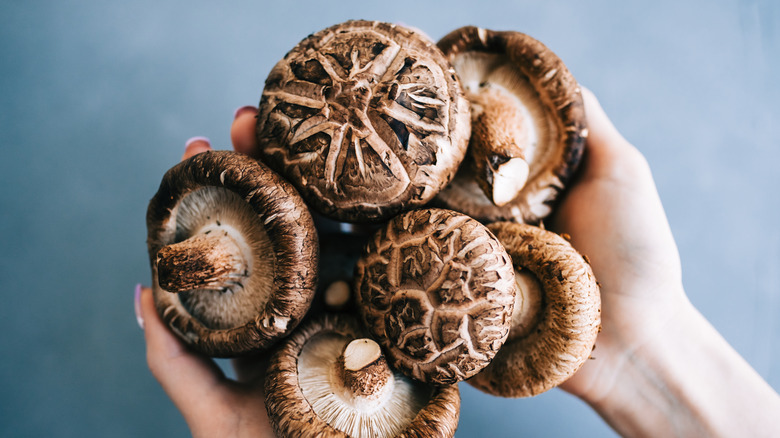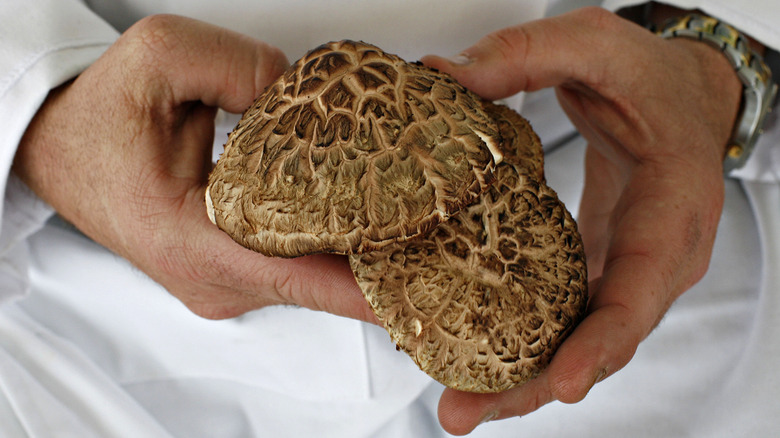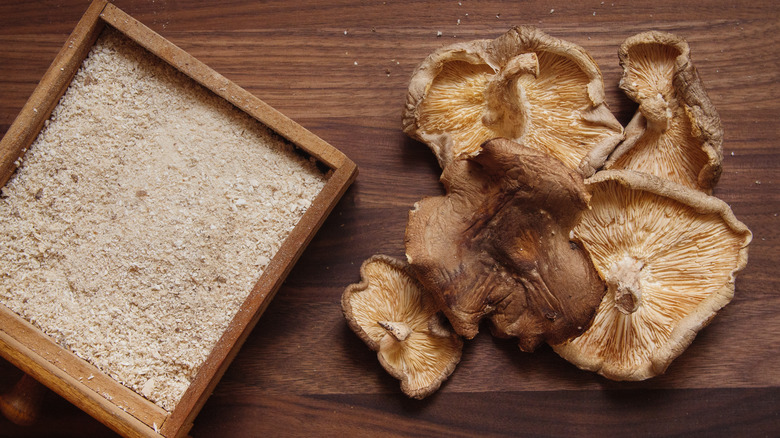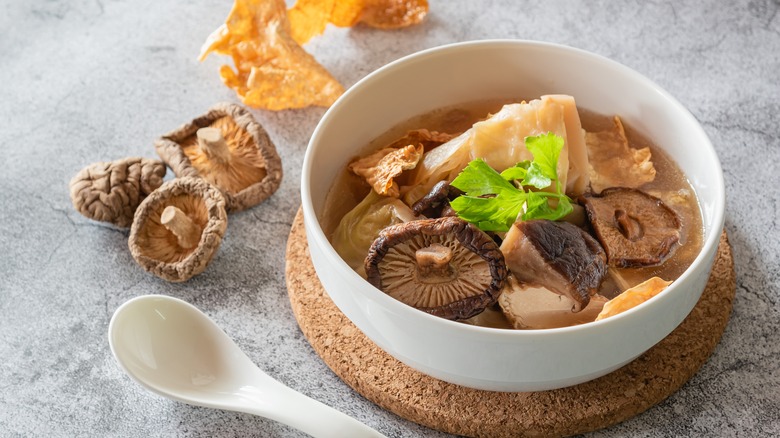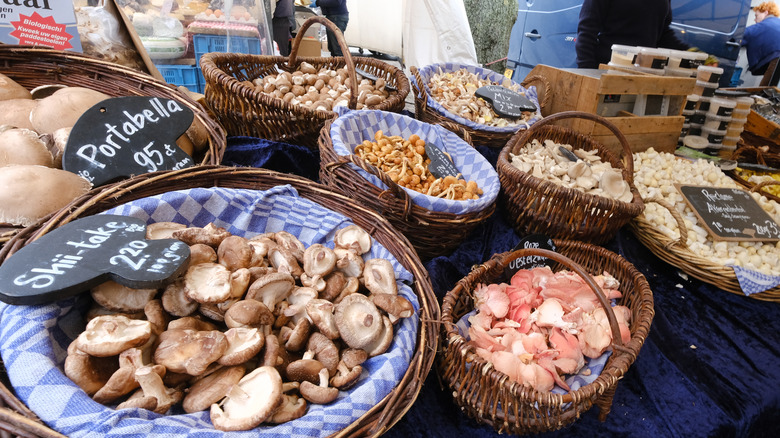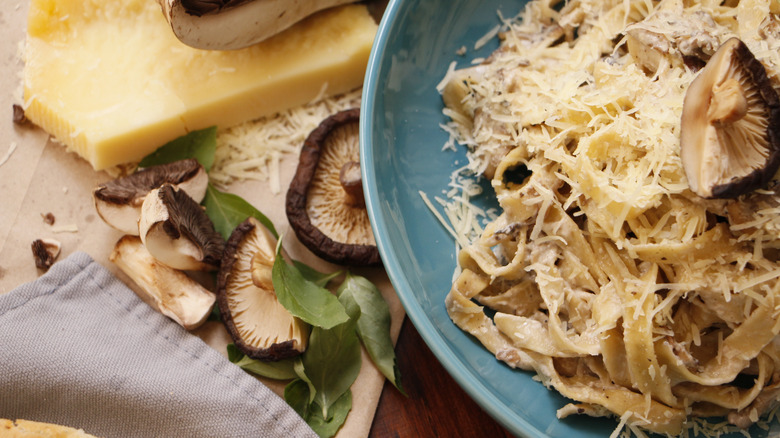What Are Shiitake Mushrooms And What Do They Taste Like?
Within the past few years, the mushroom has undergone a bit of a revival — particularly as plant-based recipes become more prevalent and as dishes from different countries gain long-deserved recognition in mainstream American cooking.
The once-trendy Portobello burger is still out there (particularly if you head to Shake Shack), and yes, you can still snag a can of cream of mushroom soup for whatever gloopy casserole you're craving, but the mushroom holds a greater potential and history than that. They can top a pizza, but why stop there?
Mushrooms are a great, umami-rich base for gravies and broths. They can serve as a taco filling, a crispy stir-fry topping, or an ingredient for vegetarian meatballs (via The New York Times). But when you've got your hands on some shiitake mushrooms — fresh or dried — the real adventure begins. This meaty, flavorful, and versatile fungi can add nutritional value, and general tastiness, to your cooking repertoire.
What are shiitake mushrooms?
The shiitake mushroom (lentinula edodes) holds a rich culinary past that spans centuries (via ScienceDirect). It originated in East Asia — more than 80% are cultivated in Japan — and has long been used as a medicinal supplement in multiple countries, including Korea and Russia, according to Healthline. The shiitake can come in varying shades of brown and grey, and can sometimes appear spotted. Beneath its cap, the mushroom can span from three to six inches and, according to the University of Vermont, is the second most commonly cultivated mushroom worldwide. And, UVM says, the mushroom has distinctive "gills" beneath its cap — similar to the flaps you'd see in a portobello mushroom.
In recent years, the shiitake's popularity has continued to flourish in the United States. It's popped up on the Panda Express menu sautéed with kale and chicken (via Eater). It's even been transformed into meatless jerky. In 2016, Clark University estimated that shiitake farming had increased by 20% in the U.S. over a mere two-year period. That's a lot of mushrooms.
What do shiitake mushrooms taste like?
The shiitake's flavor is often described as rich, buttery, or filled with umami. Umami, by the way, is known as one of the five basic tastes — along with sweet, sour, salty, and bitter — and provides savoriness to a food or dish. That full-bodied, deep flavor you get from a thick, crispy burger or charred, roasted eggplant? That experience — umami — is essential to the shiitake mushroom, and part of what makes it so exciting (via Vox).
The shiitake's texture is also distinctive. The Mushroom Council (yes, there is such a thing) describes the shiitake as "meaty," but directs home cooks to remove the stems, which are tough and stringy. But there's no need to waste any part of the 'shroom — while you're throwing that mushroom cap into a pasta dish or rice bowl, the stem can serve as the base of a flavorful vegetarian broth.
Nutritional benefits of the shiitake mushroom
They're not only tasty. Shiitakes are really good for you. According to data from Healthline, the mushroom contains substances including vitamin D, copper, fiber, and zinc. It's particularly rich in vitamin B5, which aids the metabolic process and produces red blood cells (via Medical News Today). Healthline estimates about four dried shiitakes contain a third of your recommended daily intake for vitamin B5. And, dermatologist Dr. Jeannette Graf tells the New York Times, those mushroom caps may help your skin stay healthy, too. And, WebMD reports, the shiitake contains beta-glucans, which may bolster your immune system.
Researchers at the Brazil-based University of Caxios do Sul say there are other potential benefits, like protecting the body from bacterial infections and even from tumors. But, as they write in the journal Food and Nutrition Sciences, more research is needed to draw any solid conclusions.
Where to find shiitake mushrooms
From Whole Foods to Kroger, shiitake mushrooms are featured in many major grocery stores these days. You can also likely find them at your local Asian market; they can sometimes also be labeled as a "black mushroom" (via The Baltimore Sun).
You can purchase dried shiitakes or fresh ones. Dried shiitakes can be stored sans refrigeration, according to The Kitchn. The publication writes that the dried mushroom must soak in hot or boiling water to rehydrate — and the leftover water can be used as a rich broth. The dry variety will keep in your pantry for nine months, at least, if they're stored in a properly dry and cool place. Fresh shiitakes must be cleaned, but there's no need to rehydrate them. Their shelf life is considerably shorter — they keep just a few days stored in the fridge — and Bon Appétit also suggests storing them in a wet paper towel.
How to cook shiitake mushrooms
Once they're prepped, shiitake mushrooms can be used in stews, salads, and pasta dishes — the possibilities range far and wide. The New York Times sears the chopped mushroom caps in hot oil to create a crispy salad with radicchio and barley. The mushrooms can add textural interest and variety to a meatless pasta dish — like cacio e pepe-reminiscent spaghetti with shiitakes, black pepper, and parmesan. You can even make shiitake chips, according to J. Kenji López-Alt, who slices and sautés the chopped mushrooms to use as a topping for a creamy vegan soup (via Serious Eats).
To make sure your 'shrooms get crispy, and not soggy, be sure to pat your mushrooms dry. And, avoid salting them at the beginning of the cooking process — you want to avoid drawing out moisture as you begin the quest for the perfectly crispy mushroom. We wish you luck on your shiitake journey.
